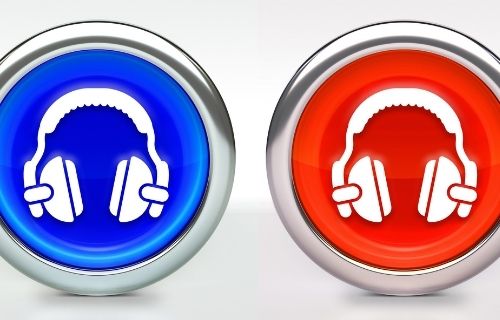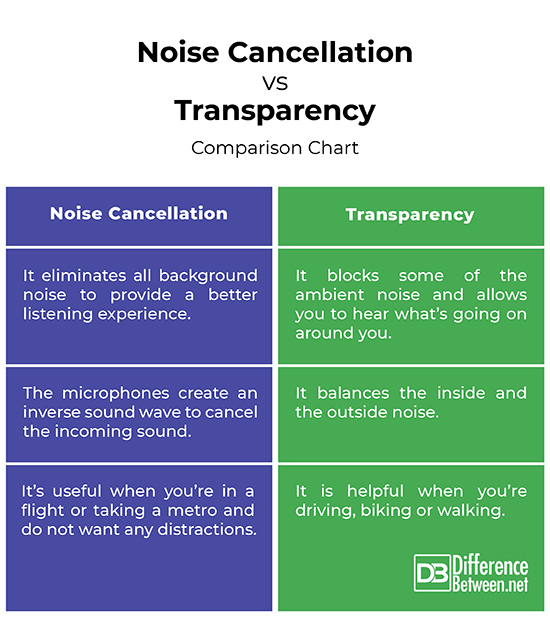Difference Between Noise Cancellation and Transparency
Different companies are releasing their own earphones, or you could say earbuds, these days with some unique features such as active noise cancellation or transparency mode for that matter. The most advertised feature of Apple’s AirPods Pro and AirPods Max is active noise cancellation. Less publicized, but equally important, is yet another mode called the transparency mode. We look at some of the differences between the two modes.

What is Noise Cancellation?
AirPods Pro and AirPods Max come with active noise cancellation and transparency modes, and you can switch between them depending on how much of the surrounding noise you want to hear. The noise cancellation feature is found on many other expensive headphones and earbuds. What it does is drown out almost everything around you, bringing peace and quiet to your ears for a smooth, undisturbed listening experience. But how does the active noise cancellation work?
Noise cancelling headphones work on a phenomenon called destructive interference. Sound waves like light waves have peaks and valleys, and no two sounds are similar. The headphones have their own built-in microphone which creates a new waveform when it detects a sound wave. Now, this waveform is the exact opposite of that sound wave which in turn cancels it out. So, all you should hear is the sound coming from the headphones and anything from the outside is just gone or minimized to an extent where it’s practically cannot be heard.

What is Transparency Mode?
The transparency mode, unlike noise cancellation, gives you a perspective of the outside world. It’s a relatively new noise control feature which is a bit difficult to explain in words. The transparency mode is basically a feature available only in the premium headphones or earbuds, for example the AirPods Pro and AirPods Max. This feature is basically bundled into any active noise cancelling pair of headphones. Apple built this force touch sensor on the side of the earbuds that when you squeeze it, it lets you listen to the outside noise around you.
The transparency mode slightly tweaks the ANC to allow most of the outside noise to come in, so you can hear what’s going on around you. So, unlike noise cancellation where the microphone cancels the noise, the transparency mode tends to bring in the ambient noise. This is actually great when you want to talk to the people nearby or simply need to hear what’s around you. The transparency mode pretty much balances the inside and the outside noise.
Difference between Noise Cancellation and Transparency
Meaning of Noise Cancellation vs Transparency
– Noise cancellation and transparency are the two sound control modes found in the more premium headphones or earphones, such as the AirPods Pro and AirPods Max, Bose QuietComfort earbuds, Sony WH-1000XM4, etc. Active Noise Cancellation (ANC), or noise cancellation, is a feature which allows you to eliminate all background noise providing a better listening experience. The transparency mode slightly tweaks the ANC to allow most of the outside noise to come in, so you can hear what’s going on around you. The transparency mode lets you hear the world around you.
Technology of Noise Cancellation vs Transparency
– Noise cancelling headphones basically place the microphones on the outside of the device to listen to the world around you and then creating an inverse sound wave to cancel the incoming sound. The transparency mode does basically the same, but instead of cancelling the ambient noise, it used the same microphones to bring in the ambient noise, so that you can hear what’s going on around you and listen to the world around you. The transparency mode balances the inside and the outside noise.
When to use the Noise Cancellation vs Transparency
– Noise cancellation blocks all the background noise. For example, when you’re in a flight or taking a metro, this feature will block all distractions, including the noise of the people talking around you. The transparency mode blocks some of the noise, so that you can listen to the music or whatever you’re listening to and also know what’s going on around you. This feature is helpful when you’re driving or biking or walking. You can listen to music or podcasts or news, without skipping conversations or important announcements.
Noise Cancellation vs. Transparency: Comparison Chart

Summary
The noise cancelling feature basically blocks all the surrounding noise from the world around you to give you a better listening experience. This feature is particularly useful when you’re travelling and do not want to be interrupted by the people talking and all the noise around you. The transparency feature is an added advantage which basically tweaks the noise-cancelling feature by allowing most of the surrounding noise to come in, so you can enjoy listening to music or whatever it is you’re listening to and also be aware of what’s happening around you.
Does noise cancelling use more battery than transparency?
Both noise cancelling and transparency modes drain the battery faster. In AirPods Pro, you get an estimate of five hours of listening time with the noise cancellation and transparency mode turned off. With the modes turned on, you get up to four hours and a half.
Does noise cancellation make a difference?
Just because a pair of headphones has noise cancelling feature, doesn’t mean it is very good. Today, almost every company has their headphones advertised as noise cancelling headphones. But, only the premium brands offer actual noise cancelling feature in their headphones, such as Apple, Bose, Sony, Sennheiser, and so on.
What is the difference between noise cancelling and noise reduction?
Noise cancelling means you’re totally unaware of the world around you, free of all distracting noises, such as vehicle movements, honking sounds, heavy equipment motion, alarms, or even shouting noises of people. Noise reduction does not completely block the outside noise, but reduces unwanted ambient noise. Also, noise reduction is basically passive.
What is transparency mode on earbuds?
The transparency mode is a noise control mode in earphones or earbuds, just like the noise cancelling feature, except transparency does not block all the ambient noise around you. It blocks some of the noise, so that you can listen to the world around you.
- Difference Between Caucus and Primary - June 18, 2024
- Difference Between PPO and POS - May 30, 2024
- Difference Between RFID and NFC - May 28, 2024
Search DifferenceBetween.net :
Leave a Response
References :
[0]Hansen, Colin N. Understanding Active Noise Cancellation. Florida, United States: CRC Press, 2002. Print
[1]Wolfe, Bryan. “AirPods Pro: What's the difference between Transparency and Noise Canceling.” iMore, 28 Jan. 2020, www.imore.com/airpods-pros-whats-difference-between-transparency-vs-noise-canceling.
[2]Truly, Alan. “AirPods Transparency Mode: What Is It & How It Works Explained.” SCREENRANT, 28 Jun. 2021, screenrant.com/apple-airpods-transparency-mode-works-purpose-benefits-explained.
